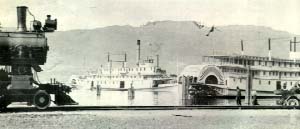|
The History of
Lumby - Transportation
When the Province
of B.C. was formed in 1871 it was promised
connection to a transcontinental railway. The first
passenger train ran into Sicamous in 1886, bringing
change along with it. There were so many new
settlers in the Okanagan Valley that the Hudson's
Bay Company built its first store here in 1887, at
Priest Valley. Priest Valley was so named because
Missionaries built a cabin at the junction of
Vernon Creek and Swan Lake Creek (near 24th Avenue
and 36th Street in present Vernon). This was a
stopping-off place," a convenient day's journey
from Okanagan Mission." 
By 1887 Priest
Valley,the community of about forty residents had
officially been renamed Vernon, in honour of George
Forbes Vernon, although it was not incorporated as
a town until December 30, 1892 when it became the
first town in the valley to do so. By 1904 Vernon
was the largest town in the Okanagan Valley.
In the early days
there were no roads, and the only transportation up
and down the lakes were steamboats. The CPR
steamboats operated on Okanagan Lake until the
mid-1930's. Regular steamboat service on the lake
began in 1893. Prior to that time, travel was only
possible by horseback on primitive roads and
trails, or by private boats.
By 1892 the
Shuswap and Okanagan Railway was completed, linking
the valley with the CPR mainline in Sicamous. The
S&O ran through Vernon to Okanagan Landing,
where it was connected with the steamboats. All the
Canadian Pacific boats were constructed at Okanagan
Landing. The most important boats were the Stern
Wheelers 'The SS Aberdeen', 'The SS Okanagan', and
'The SS Sicamous'. The combined CPR train and boat
service played a large part in opening up the
Okanagan Valley. It brought in new settlers; it
connected remote settlement; it carried freight,
mail and supplies; it took fruit to the market; and
it served to some extent, as a focus for social
activity.
The economic slump
which followed the First World War reduced the need
for boat service on the lake. The Kettle Valley
Railway had already arrived in the Okanagan and
another rail-line eventually linked Vernon and
Kelowna. Roads were being built and improved.
Though the boats had played a vital role bringing
the Okanagan into the twentieth century, they could
not keep pace with development of the valley. The
last of the paddle wheelers, the 'The SS Sicamous',
was retired in 1936. She lay at anchor at Okanagan
Landing until 1951, when she was purchased by the
City of Penticton for $1. She was towed down the
lake where she is moored at the south end of
Okanagan lake.
As well as
passenger boats the CPR provided a number of tugs
on the lake as well. They were tied together by a
railroad barge service - barges with tracks on them
onto which box cars were rolled. They were handled
by tugs. One of the tugs was the steam-powered
Naramata, launched in 1914. With the decline in
traffic in the 1930's she was moored at Okanagan
Landing and given to the Okanagan Landing Community
Association, who restored her. She may be seen at
Paddlewheel Park in Okanagan landing.
| 
